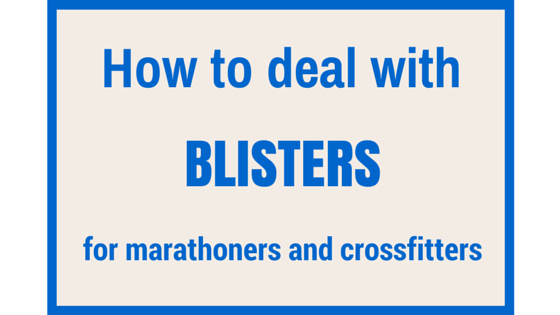How to deal with blisters for marathoners and crosffiters
It will happen either in your hand or on your feet when you amp up your training over time. Prevention is always better than treatment as with any injury. Here are tips for you on how to avoid blisters and also how to tread them, once they occur.
How you avoid blisters while running
When you run a marathon you will clock a lot of miles in your training. Your running shoes should be snug on your feet and not leave too much room. The more space there is for your feet within your shoes to move around the more likely it will be that you will develop a blister. Same goes for your socks. You can apply some baby powder to keep away the moisture. The shoes and socks should be able to let air to your feet and out of it, so that the sweat is not building up within the shoe and soaks your feet. Also avoid to lace your shoes too tight. This is firstly not good for the blood flow to the feet and secondly can also be a cause of blisters.
Moisture and friction should be avoided and the best prevention is proper clothing for a marathon and your running training. If you are in a wet country (like me in Ireland) make also sure that you have a place to dry your shoes after a wet run. I personally do not avoid puddles when I am running and it is ok to keep the feet wet during the run, because my gear has a good fit. But after I take care that they dry quick for the run on the next day.
How to avoid blisters for crossfit
Blisters in your hand will most likely develop when working with a barbell. Here the best prevention technique is to develop a proper grip and use chalk. The less tight your grip is, the less you will lift and the more likely it will be that the metal of the barbell has some leeway to create blisters in your hand.
For rope climbs and sled pulls same applies. Proper grip and technique will prevent blisters from forming. As long as it is not a competition it is usually not worth it to move so quick that you rip off the skin from your palms and fingers. Keep this madness for competition and don't do it in training. If you can avoid it don't do it at all. If there is a follow up event after the rope climb your beat up hands will inhibit optimum performance.
You can also use barbells for beginners and stay away from the competition metal, as it is usually rougher on the skin for more grip, than the less rough training barbells.
What you can do when a blister has formed
There are two different types of blisters, the ones that popped and the ones that did not. If you have an unpopped blister, avoid opening it up. This is usually more painful and exposes you to more risk of infection, than letting it be.
For crossfit you can make use of blister plasters and cover the area with a glove. When I ran the Vienna marathon I got compeed blister plasters and applied accordingly. I was bale to run the entire marathon without any pain and the plaster stayed on. I would recommend to cover up a popped blister with a blister plaster.
Further reading
On kettlebells
- Can I kettlebell train every day?
- Can kettlebells build muscle?
- Can kettlebell swings hurt my back?
- Can kettlebell swings replace cardio?
- Can kettlebell swings replace deadlifts?
- How many kettlebell swings?
- How many times will you kettlebell to see remarkable results
- How the simple kettlebell works for your well being
- How to kettlebell swing to get amazingly strong
- When the killer kettlebell gets results and high performance
- Where do kettlebell swings target?
- Where to buy kettlebell sets?
- Which kettlebell should a woman start with?
- Which kettlebell weight should I buy?
- Why is kettlebell training so effective?
- Will kettlebells get you ripped?
- Will kettlebell swings burn fat?
On the squat
- Are you sure about wearing the right shoes for squatting
- Bench press or squat first
- Bench press in a squat rack
- Better breathing makes your squat stronger
- Breathing Squat
- Can you squat and deadlift on the same day
- Challenge, Sore
toda , Strong tomorrow - Confidential: Get rid of the machines and hire the squat
- Detailed Smolov squat routine review
- Eager to know about wearing the right suit for squatting
- How to perform a back squat for
crossfit for beginners - How years of quality cossack squats easily help your fitness
- Overcome these sins of the squat
- Squat: How many reps
- Squat: How to improve
- Squat: When to inhale and exhale
- Squat without pads
- Squat Calculator [Free Downloads]
- The Truth squat or lunges?
- Ultimate 30 day squat challenge that
tighten and tone


